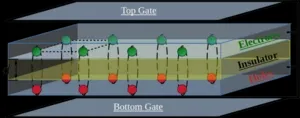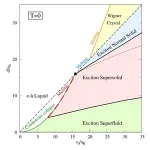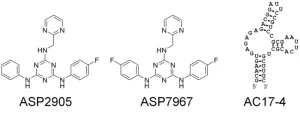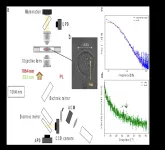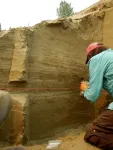(Press-News.org) A collaboration of Australian and European physicists predict that layered electronic 2D semiconductors can host a curious quantum phase of matter called the supersolid.
The supersolid is a very counterintuitive phase indeed. It is made up of particles that simultaneously form a rigid crystal and yet at the same time flow without friction since all the particles belong to the same single quantum state.
A solid becomes ‘super’ when its quantum properties match the well-known quantum properties of superconductors. A supersolid simultaneously has two orders, solid and super:
solid because of the spatially repeating pattern of particles,
super because the particles can flow without resistance.
“Although a supersolid is rigid, it can flow like a liquid without resistance,” explains Lead author Dr Sara Conti (University of Antwerp).
The study was conducted at UNSW (Australia), University of Antwerp (Belgium) and University of Camerino (Italy).
A 50-YEAR JOURNEY TOWARDS THE EXOTIC SUPERSOLID
Geoffrey Chester, a Professor at Cornell University, predicted in 1970 that solid helium-4 under pressure should at low temperatures display:
Crystalline solid order, with each helium atom at a specific point in a regularly ordered lattice and, at the same time,
Bose-Einstein condensation of the atoms, with every atom in the same single quantum state, so they flow without resistance.
However in the following five decades the Chester supersolid has not been unambiguously detected.
Alternative approaches to forming a supersolid-like state have reported supersolid-like phases in cold-atom systems in optical lattices. These are either clusters of condensates or condensates with varying density determined by the trapping geometries. These supersolid-like phases should be distinguished from the original Chester supersolid in which each single particle is localised in its place in the crystal lattice purely by the forces acting between the particles.
The new Australia-Europe study predicts that such a state could instead be engineered in two-dimensional (2D) electronic materials in a semiconductor structure, fabricated with two conducting layers separated by an insulating barrier of thickness d.
One layer is doped with negatively-charged electrons and the other with positively-charged holes.
The particles forming the supersolid are interlayer excitons, bound states of an electron and hole tied together by their strong electrical attraction. The insulating barrier prevents fast self-annihilation of the exciton bound pairs. Voltages applied to top and bottom metal ‘gates’ tune the average separation r0 between excitons.
The research team predicts that excitons in this structure will form a supersolid over a wide range of layer separations and average separations between the excitons. The electrical repulsion between the excitons can constrain them into a fixed crystalline lattice.
“A key novelty is that a supersolid phase with Bose-Einstein quantum coherence appears at layer separations much smaller than the separation predicted for the non-super exciton solid that is driven by the same electrical repulsion between excitons,” says co-corresponding author Prof David Neilson (University of Antwerp).
“In this way, the supersolid pre-empts the non-super exciton solid. At still larger separations, the non-super exciton solid eventually wins, and the quantum coherence collapses.”
“This is an extremely robust state, readily achievable in experimental setups,” adds co-corresponding author Prof Alex Hamilton (UNSW). “Ironically, the layer separations are relatively large and are easier to fabricate than the extremely small layer separations in such systems that have been the focus of recent experiments aimed at maximising the interlayer exciton binding energies.”
As for detection, for a superfluid it is well known that this cannot be rotated until it can host a quantum vortex, analogous to a whirlpool. But to form this vortex requires a finite amount of energy, and hence a sufficiently strong rotational force. So up to this point, the measured rotational moment of inertia (the extent to which an object resists rotational acceleration) will remain zero. In the same way, a supersolid can be identified by detecting such an anomaly in its rotational moment of inertia.
The research team has reported the complete phase diagram of this system at low temperatures.
“By changing the layer separation relative to the average exciton spacing, the strength of the exciton-exciton interactions can be tuned to stabilise either the superfluid, or the supersolid, or the normal solid,” says Dr Sara Conti.
“The existence of a triple point is also particularly intriguing. At this point, the boundaries of supersolid and normal-solid melting, and the supersolid to normal-solid transition, all cross. There should be exciting physics coming from the exotic interfaces separating these domains, for example, Josephson tunnelling between supersolid puddles embedded in a normal-background.”
THE STUDY
Chester Supersolid of Spatially Indirect Excitons in Double-Layer Semiconductor Heterostructures was published in Physical Review Letters. (DOI 10.1103/physrevlett.130.057001)
In addition to the Australian Research Council, the work was supported by the Research Foundation-Flanders (FWO-Vl).
END
Can a solid be a superfluid? Engineering a novel supersolid state from layered 2D materials
Bilayer excitons form a quantum supersolid
2023-03-30
ELSE PRESS RELEASES FROM THIS DATE:
ASU associate professor wins Fulbright Award to study sexual-assault prevention
2023-03-30
Throughout her career, Arizona State University Edson College of Nursing and Health Innovation Associate Professor Kelly Davis has worked to translate her research into action. An expert in alcohol-involved sexual assault, Davis’ studies have been cited in U.S. legislation and have earned her a MERIT Award and now the prestigious Fulbright Scholar Award.
The program will take her to the United Kingdom beginning in early 2024 to collaborate with colleagues at the University ...
New RNA-based toolkit to regulate gene activity could advance regenerative medicine, gene therapy and biotechnology
2023-03-30
The Okinawa Institute of Science and Technology (OIST), in collaboration with Astellas Pharma Inc., has developed a new toolkit that uses small molecules to control the activity of a piece of synthetic RNA, and ultimately regulate gene expression. The technology, which was described in the Journal of the American Chemical Society on March 30, 2023, worked in mammalian cell cultures and in mice.
The ability to precisely control whether a gene is turned on or off is expected to lead to more efficient production of compounds that are made using animal cells, and make gene therapy, cell therapy, and regenerative medicine safer.
For genes to be expressed, cells make many RNA copies of a section ...
Babies’ gut microbiome not influenced by mothers’ vaginal microbiome composition
2023-03-30
It has been a longstanding assumption that birth mode and associated exposure of newborns to their mothers’ vaginal microbiome during delivery greatly affects the development of babies’ gut microbiome.
To test the scientific validity of this assumption, a team of Canadian researchers has now published a study in Frontiers in Cellular and Infection Microbiology in which they examined the effect of maternal vaginal microbiome composition on the development of infants’ stool microbiome at 10 days and three months after birth.
“We show that ...
2023 Canada Gairdner Awards recognize world-renowned scientists for transformative contributions to research impacting human health
2023-03-30
The Gairdner Foundation is pleased to announce the 2023 Canada Gairdner Award laureates, recognizing some of the world’s most significant biomedical and global health research and discoveries.
“Congratulations to all the 2023 Canada Gairdner Award recipients! The ground-breaking work of this year’s laureates has resulted in innovative, globally accessible tools to fight diseases and improve our well-being. The work of two Canadian researchers – Dr. Christopher Mushquash and Dr. Gelareh Zadeh especially ...
Researchers use tiny diamonds to create intracellular sensors
2023-03-30
Researchers use tiny diamonds to create intracellular sensors
Optically trapped nanodiamonds could be used to measure temperature, magnetic fields and other properties inside living cells
VANCOUVER -- Researchers have developed a new way to study the intricate dynamics within living cells by using optically trapped nanodiamond particles as intracellular sensors. Using custom built optical tweezers, the research team trapped the particles within the cell at low power while the cell was alive. The work represents an important advancement in quantum sensing, which takes advantage of quantum mechanics to analyze changes at the atomic level.
The researchers used optical tweezers ...
New study identifies key risk factors for surgical site infection following commonly performed surgery
2023-03-30
Arlington, Va., March 30, 2023 – Findings from an analysis of more than 66,000 abdominal hysterectomies performed in New York hospitals reveal key risk factors for surgical site infections (SSIs) following these procedures, including open surgery, obesity, diabetes, gynecological cancer, and age under 45. Published today in the American Journal of Infection Control (AJIC), the data can help inform surgical and clinical decisions to reduce post-operative infections.
“Improved understanding of patient-related, clinical, and surgical factors ...
Limit screen use in children under six, says psychologist
2023-03-30
“Children who are in regular contact with mobile phone screens, tablets or computers are more irritable and have worse attention, memory and concentration than those who do not use them.”
Parents should strictly ration or not allow screen time for children aged under six, according to a leading neuropsychologist in a new book.
Dr Álvaro Bilbao, Ph.D., uses current and established research to highlight how the risk of psychological and behavioral issues increases the ...
Most of world’s salt marshes likely to be underwater by 2100, study concludes
2023-03-29
By Emily Greenhalgh
WOODS HOLE, MASS. -- Cape Cod’s salt marshes are as iconic as they are important. These beautiful, low-lying wetlands are some of the most biologically productive ecosystems on Earth. They play an outsized role in nitrogen cycling, act as carbon sinks, protect coastal development from storm surge, and provide critical habitats and nurseries for many fish, shellfish, and coastal birds.
And, according to new research from the Marine Biological Laboratory (MBL), more than 90 percent of ...
Insilico Medicine featured in BBC-produced series on biotech breakthroughs
2023-03-29
Insilico Medicine (“Insilico”) is featured in the new BBC StoryWorks-produced film series Nature’s Building Blocks made in conjunction with the Biotechnology Innovation Organization (BIO). Through 29 short films, the series showcases science innovations and cutting-edge technological advances that are poised to dramatically improve human life.
Insilico, a generative artificial intelligence (AI)-driven drug discovery company, is featured in a segment focused on democratizing and accelerating ...
A reconstruction of prehistoric temperatures for some of the oldest archaeological sites in North America
2023-03-29
Scientists often look to the past for clues about how Earth’s landscapes might shift under a changing climate, and for insight into the migrations of human communities through time. A new study offers both by providing, for the first time, a reconstruction of prehistoric temperatures for some of the first known North American settlements.
The study, published in Quaternary Science Reviews, uses new techniques to examine the past climate of Alaska’s Tanana Valley. With a temperature record that reaches back 14,000 years, researchers now have ...
LAST 30 PRESS RELEASES:
Tracing the quick synthesis of an industrially important catalyst
New software sheds light on cancer’s hidden genetic networks
UT Health San Antonio awarded $3 million in CPRIT grants to bolster cancer research and prevention efforts in South Texas
Third symposium spotlights global challenge of new contaminants in China’s fight against pollution
From straw to soil harmony: International team reveals how biochar supercharges carbon-smart farming
Myeloma: How AI is redrawing the map of cancer care
Manhattan E. Charurat, Ph.D., MHS invested as the Homer and Martha Gudelsky Distinguished Professor in Medicine at the University of Maryland School of Medicine
Insilico Medicine’s Pharma.AI Q4 Winter Launch Recap: Revolutionizing drug discovery with cutting-edge AI innovations, accelerating the path to pharmaceutical superintelligence
Nanoplastics have diet-dependent impacts on digestive system health
Brain neuron death occurs throughout life and increases with age, a natural human protein drug may halt neuron death in Alzheimer’s disease
SPIE and CLP announce the recipients of the 2025 Advanced Photonics Young Innovator Award
Lessons from the Caldor Fire’s Christmas Valley ‘Miracle’
Ant societies rose by trading individual protection for collective power
Research reveals how ancient viral DNA shapes early embryonic development
A molecular gatekeeper that controls protein synthesis
New ‘cloaking device’ concept to shield sensitive tech from magnetic fields
Researchers show impact of mountain building and climate change on alpine biodiversity
Study models the transition from Neanderthals to modern humans in Europe
University of Phoenix College of Doctoral Studies releases white paper on AI-driven skilling to reduce burnout and restore worker autonomy
AIs fail at the game of visual “telephone”
The levers for a sustainable food system
Potential changes in US homelessness by ending federal support for housing first programs
Vulnerability of large language models to prompt injection when providing medical advice
Researchers develop new system for high-energy-density, long-life, multi-electron transfer bromine-based flow batteries
Ending federal support for housing first programs could increase U.S. homelessness by 5% in one year, new JAMA study finds
New research uncovers molecular ‘safety switch’ shielding cancers from immune attack
Bacteria resisting viral infection can still sink carbon to ocean floor
Younger biological age may increase depression risk in older women during COVID-19
Bharat Innovates 2026 National Basecamp Showcases India’s Most Promising Deep-Tech Ventures
Here’s what determines whether your income level rises or falls
[Press-News.org] Can a solid be a superfluid? Engineering a novel supersolid state from layered 2D materialsBilayer excitons form a quantum supersolid

